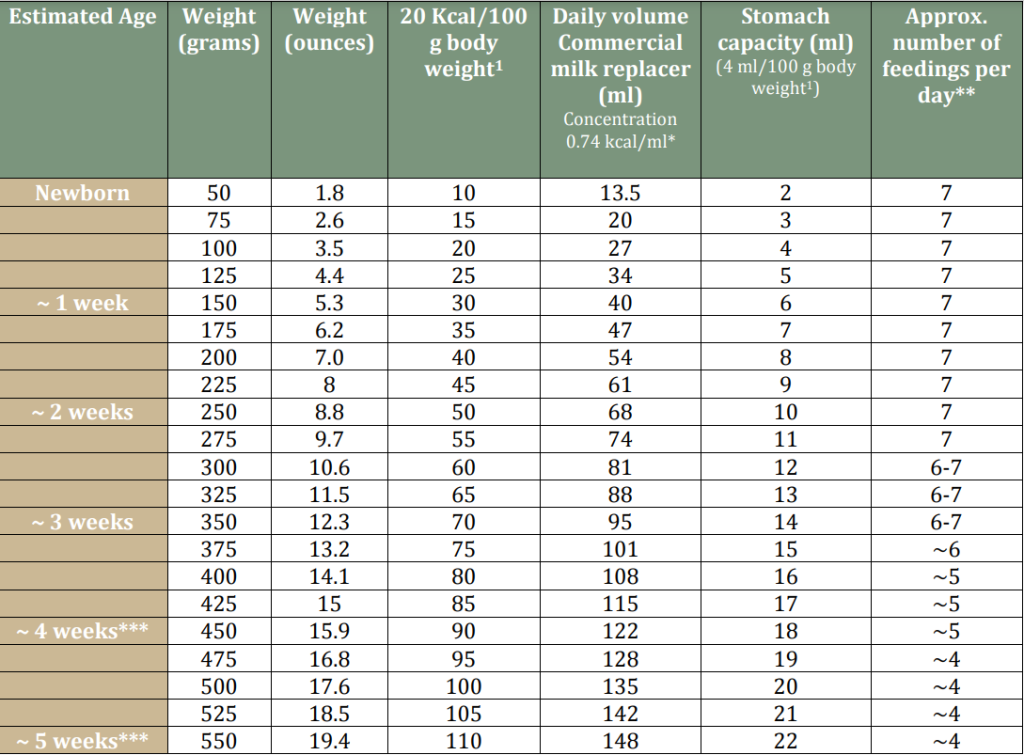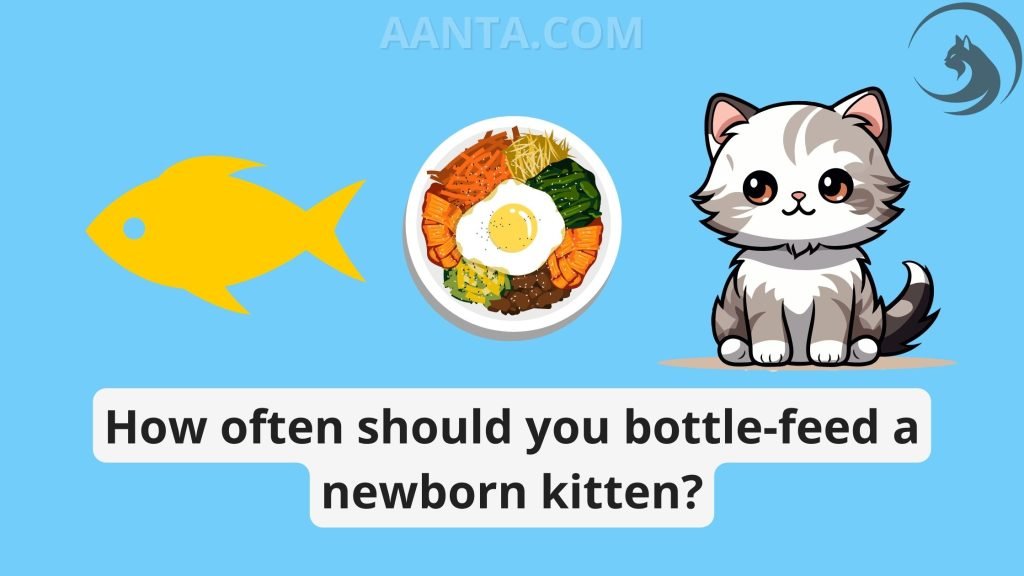Newborn kitten and bottle-feed: When a kitten is orphaned, the responsibility falls on us to provide care. Becoming proficient in bottle feeding is essential for anyone rescuing kittens, and Kitten Lady streamlines the learning curve with her thorough, step-by-step guide. While anyone can learn to bottle feed, it’s important to adhere to safety guidelines. Let’s begin!
How do I know if my newborn kitten is well-fed?

When bottle-feeding kittens, we provide more milk than a nursing mother naturally produces. Healthy kittens don’t require feeding every two hours. Encourage long naps for the kittens and avoid waking them for feedings. Over time, this helps expand their stomach capacity, reducing the frequency of feedings compared to the previous every-two-hour routine.
Guidelines for bottle-feeding kittens:
- Ensure warmth as kittens struggle to digest food properly when their body temperature is low.
- Prepare milk replacer specifically formulated for kittens, following package instructions. Avoid using cow’s milk and stick to the same formula.
- Generally, kittens should consume around two tablespoons or 30 mL of formula for every 4 ounces of body weight within 24 hours. Adjust feeding amounts based on weight gain.
- Kittens recently weaned from their mothers may take time to adjust to reduced feeding frequency.
- After initial feedings, even tiny kittens can extend the time between feedings beyond two hours.
- Prioritize feeding weak, sick, or underweight kittens to prevent hypoglycemia.
- Avoid disrupting a sleeping kitten for feeding, as uninterrupted sleep is crucial for their development.
- Minimize vibrations and disturbances at night to promote longer and deeper sleep for kittens.
How many mL of milk should a newborn kitten drink

- Energy requirements for kittens are typically between 20-26 calories per 100 grams of body weight per day.
- A comfortable stomach capacity for kittens is approximately 4ml per 100 grams of body weight.
- The challenge lies in balancing the quantity of milk required to meet caloric needs without overfilling the stomach, which can lead to gastrointestinal issues.
- Bottle-fed kittens tend to grow more slowly than those fed by their mothers due to several factors. One reason is that kittens adapt well to the amount of milk they receive, allowing for a gradual increase in food intake and a decrease in the number of meals per day. However, this can surpass the recommended stomach capacity, putting kittens at risk of regurgitation, aspiration, and diarrhea.
- As kittens transition to solid food, their reliance on milk replacers decreases, meeting their daily caloric needs more efficiently. This shift towards solid food consumption may lead to less frequent milk feedings.
When can newborn kittens start eating solid food?

In the first year of a kitten’s life, rapid growth occurs, with the majority happening within the initial six months, according to Anthony, owner and medical director of the Aurora Cat Hospital and Hotel in Aurora, Colorado. Kittens typically double their birth weight within the first two weeks, progressing from around 100 grams to 6 pounds.
Since a mother cat only provides milk, ensuring her comfort is crucial for pet owners. Anthony recommends providing easy access to food, water, and a litter box for the mother cat, as she is the primary source of nutrition for the kittens. To sustain milk production and care for her litter, the mother cat requires frequent feeding throughout the day. For individuals fostering kittens or tending to feral cats, assuming the role of a mother cat while bottle-feeding becomes necessary for a similar duration.
Introducing solid food to kittens requires caution to avoid digestive issues or reluctance to nurse. The weaning process should be gradual, commencing with small amounts of wet kitten food mixed with water to create a gruel-like consistency. Over several weeks, kittens can transition to consuming solid food exclusively. This developmental milestone signals the beginning of a healthy and vibrant life for the kittens.
What to do if a newborn kitten is injured

Kittens, despite their resilience, are not immune to injury, making it essential for responsible caregivers to remain vigilant in identifying potential issues. In this article, we’ll explore common signs of kitten injury and offer practical tips to prevent accidents, ensuring your cat’s safety and well-being.
How can I protect my cat from injury?
The key to safeguarding your new cat is close monitoring and implementing home safety measures.
Avoid letting them leap from significant heights and aim to restrict jumps to less than three feet to maintain their bone strength. Misjudging distances during jumps can lead to awkward landings and potential injury.
Secure cabinets and areas behind appliances to prevent cats from getting trapped or injured, and keep doors and windows closed until your cat is accustomed to the outdoors.
What are the signs of an injured cat?
While it’s impossible to monitor your cat constantly, being able to recognize signs of injury is crucial for their well-being. While some injuries may be obvious, others may not be immediately apparent, especially since cats may not always express pain audibly. Consequently, identifying infections or discomfort in kittens can be challenging but essential for prompt treatment and care.
Signs of injury in cats can manifest in various ways. Cats with painful limbs may exhibit limping or struggle to walk normally. Observing any swelling or tenderness in specific areas can also indicate potential injury. Additionally, be mindful of any excessive scratching, as it may signal discomfort or an attempt to alleviate pain. Changes in behavior, such as unusual aggression, increased hiding, or reluctance to engage in usual activities, can also be indicators of underlying discomfort or injury.
By remaining attentive to your cat’s behavior and promptly addressing any signs of distress or injury, you can ensure they receive the necessary care and support to maintain their health and well-being. Regular veterinary check-ups can also help detect any issues early on and prevent them from escalating into more serious conditions.
Can you overfeed a newborn kitten?
When bottle-feeding your kitten, it’s essential to create a calm and nurturing environment. Hold the bottle of formula near your kitten’s mouth, ensuring it’s at a comfortable angle for them to latch onto. Allow them to feed at their own pace, as forcing them can lead to stress and reluctance to eat. If the kitten doesn’t immediately start feeding, you can gently soothingly stroke their forehead. This mimics the mother’s grooming behavior, which not only comforts the kitten but also encourages them to eat. Remember, patience is key during this bonding and feeding process.
It’s recommended to feed kittens every 3 hours, regardless of the time of day, to ensure they receive adequate nutrition for their growth and development. Many caregivers find it helpful to set alarms to remind them of feeding times, especially during the night when interruptions to sleep can occur. Consistency in feeding schedules is crucial to prevent digestive issues such as diarrhea or dehydration, which can arise from skipping meals or overfeeding.
After each feeding session, it’s important to help the kitten release any trapped air in their stomach, much like burping a human baby. Lay the kitten gently on its stomach and softly pat or press on its back until you hear a small burp. This may need to be repeated several times to ensure the kitten is comfortable and free from any discomfort caused by trapped air. By following these steps with care and attention, you can ensure that your kitten’s feeding experience is not only nourishing but also comforting and conducive to their overall well-being.
CONCLUSION
Mastering the art of bottle-feeding newborn kittens is not just a responsibility but a vital aspect of ensuring their health and growth. With proper guidance and commitment, anyone can excel in this essential task, contributing to the well-being of these delicate creatures. Expert advice and tips, such as those offered by Kitten Lady, can serve as invaluable resources, providing insights and techniques to ensure our kittens receive the nourishment they require to flourish.
Moreover, maintaining the health and safety of our kittens encompasses more than just feeding. It involves a holistic approach, including understanding their feeding schedule, being vigilant for signs of injury or infection, and taking proactive steps to kitten-proof our homes to create a safe environment. By addressing these aspects with affection and diligent care, we can provide the foundation for these tiny bundles of joy to grow into happy and thriving cats, enriching our lives in the process.
FAQs
1. How do I know if my newborn kitten is enough feedding?
When bottle-feeding kittens, providing more milk than a nursing mother produces is essential. Encourage long naps and avoid waking them for feedings to expand their stomach capacity gradually.
2. How many mL of milk should a newborn kitten drink?
Energy requirements for kittens are typically between 20-26 calories per 100 grams of body weight per day. A comfortable stomach capacity for kittens is approximately 4ml per 100 grams of body weight.
3. When can newborn kittens begin eating solid food?
Introducing solid food to kittens should be gradual, starting with small amounts of wet kitten food mixed with water. Over several weeks, they can transition to consuming solid food exclusively, typically around four to six weeks of age.
4. What to do if a newborn kitten is injured?
It’s essential to remain vigilant in identifying potential issues and implementing preventive measures. Signs of injury include limping, swelling, excessive scratching, changes in behavior, or vocalization indicating pain.
5. Can you Enough feeding a newborn kitten?
Feeding every three hours, regardless of the time of day, is crucial to prevent overfeeding or underfeeding. Consistent feeding schedules and burping after each feeding session help maintain their health and prevent digestive issues.







